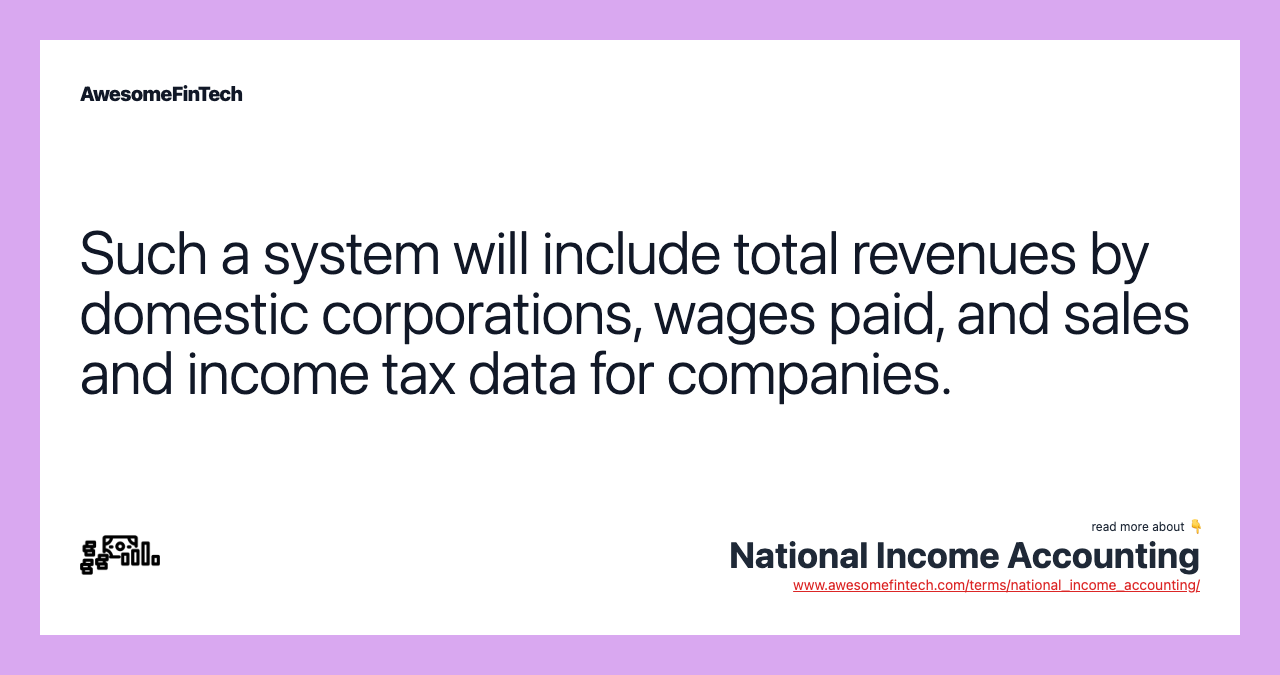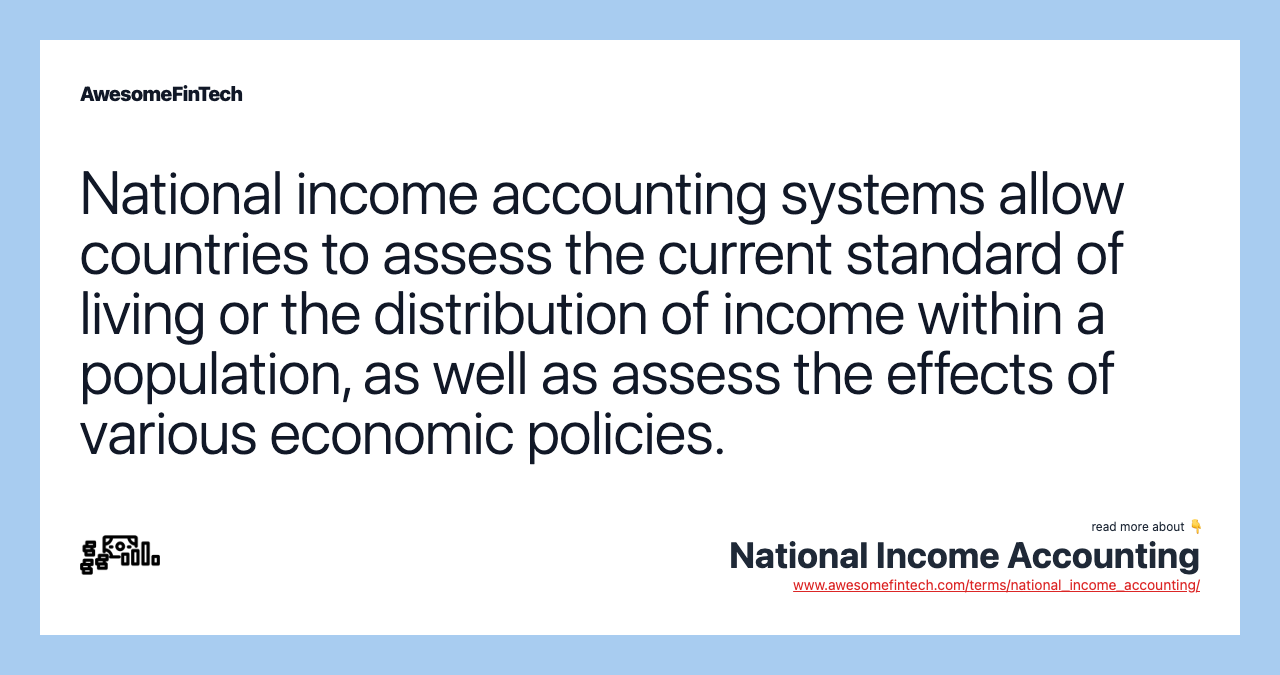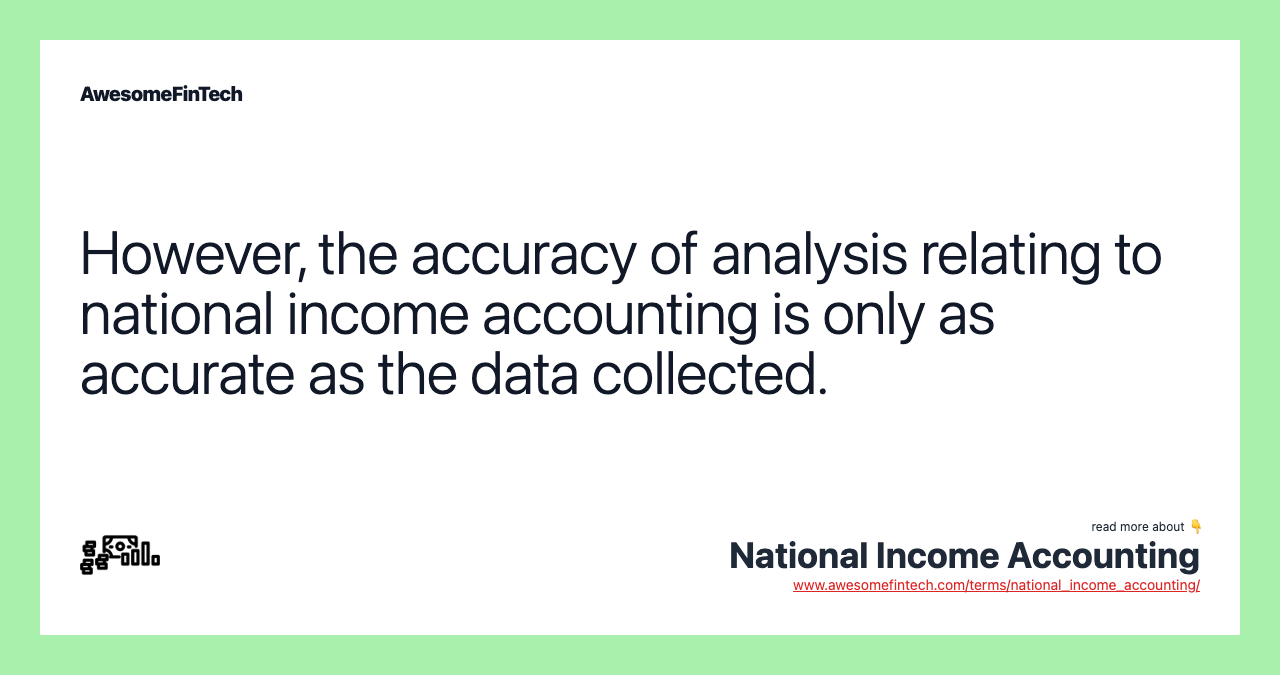National Income Accounting
National income accounting is a bookkeeping system that a government uses to measure the level of the country's economic activity in a given time period. As an example, the basic accounting identity for GDP, sometimes known as the national income identity, is computed using the following formula: GDP = consumption + investment + government spending + (exports − imports) The quantitative information associated with national income accounting can be used to determine the effect of various economic policies. Some of the metrics calculated by using national income accounting include the gross domestic product (GDP), gross national product (GNP), and gross national income (GNI). Considered an aggregate of the economic activity within a nation, national income accounting provides economists and statisticians with detailed information that can be used to track the health of an economy and to forecast future growth and development. National income accounting systems allow countries to assess the current standard of living or the distribution of income within a population, as well as assess the effects of various economic policies.

What Is National Income Accounting?
National income accounting is a bookkeeping system that a government uses to measure the level of the country's economic activity in a given time period. Accounting records of this nature include data regarding total revenues earned by domestic corporations, wages paid to foreign and domestic workers, and the amount spent on sales and income taxes by corporations and individuals residing in the country.




Understanding National Income Accounting
Although national income accounting is not an exact science, it provides useful insight into how well an economy is functioning, and where monies are being generated and spent. When combined with information regarding the associated population, data regarding per capita income and growth can be examined over a period of time.
Some of the metrics calculated by using national income accounting include the gross domestic product (GDP), gross national product (GNP), and gross national income (GNI). The GDP is widely used for economic analysis on the domestic level and represents the total market value of the goods and services produced within a specific nation over a selected period of time.
Special Considerations
The information collected through national income accounting can be used for a variety of purposes, such as assessing the current standard of living or the distribution of income within a population. Additionally, national income accounting provides a method for comparing activities within different sectors in an economy, as well as changes within those sectors over time. A thorough analysis can assist in determining overall economic stability within a nation.
For example, the U.S. uses information regarding the current GDP in the formation of various policies. During the financial crisis of 2008, the GDP began to suffer as increased market volatility and shifting supply and demand affected consumer spending and employment levels. As a result, President Barack Obama, after taking office in 2009, instituted an economic stimulus package in response.
As an example, the basic accounting identity for GDP, sometimes known as the national income identity, is computed using the following formula:
National Income Accounting vs. Economic Policy
The quantitative information associated with national income accounting can be used to determine the effect of various economic policies. Considered an aggregate of the economic activity within a nation, national income accounting provides economists and statisticians with detailed information that can be used to track the health of an economy and to forecast future growth and development.
The data can provide guidance regarding inflation policy and can be especially useful in the transitioning economies of developing nations, as well as statistics regarding production levels as related to shifting labor forces.
This data is also used by central banks to set and adjust monetary policy and affect the risk-free rate of interest that they set. Governments also look at figures such as GDP growth and unemployment to set fiscal policy in terms of tax rates and infrastructure spending.
Criticism of National Income Accounting
The accuracy of analysis relating to national income accounting is only as accurate as the data collected. Failure to provide the data in a timely fashion can render it useless in regard to policy analysis and creation.
Additionally, certain data points are not examined, such as the impact of the underground economy and illegal production. This means the activities are not reflected in the analysis even if their effect on the economy is strong. As a result, certain national accounts such as GDP or the consumer price index (CPI) of inflation have been criticized on the grounds that they do not accurately capture the real economic condition of the economy.
Related terms:
Accounting Records
Accounting records include all documentation involved in the preparation of financial statements or records relevant to audits and financial reviews. read more
American Recovery and Reinvestment Act (ARRA)
The American Recovery and Reinvestment Act of 2009 (ARRA) was a law passed by the U.S. Congress in response to the Great Recession of 2008. read more
Bureau of Economic Analysis (BEA)
The Bureau of Economic Analysis (BEA), a division of the U.S. Department of Commerce, is responsible for the analysis and reporting of economic data. read more
Consumer Price Index (CPI)
The Consumer Price Index (CPI) measures the average change in prices over time that consumers pay for a basket of goods and services. read more
Domestic Corporation
A domestic corporation is a business that conducts its affairs in its home country, or in the state where it was incorporated. read more
Fiscal Policy : Types & Tools
Fiscal policy uses government spending and tax policies to influence macroeconomic conditions, including aggregate demand, employment, and inflation. read more
What Are Flow of Funds Accounts?
Flow Of Funds (FOF) are accounts that track the flow of money to and from various sectors of a national economy. read more
Gross Domestic Income (GDI)
Gross domestic income (GDI) is a measure of economic activity based on all the income earned while engaged in said economic activity. read more
Gross Domestic Product (GDP)
Gross domestic product (GDP) is the monetary value of all finished goods and services made within a country during a specific period. read more
Gross National Product (GNP)
Gross national product (GNP) is an economic statistic that includes GDP, plus any income earned by a residents from overseas investments, minus income earned within the domestic economy by foreign residents. read more